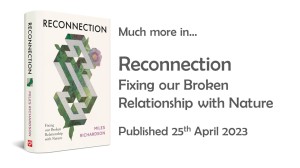Last week the Government pledged to ‘boost Britain’s access to nature’ and ‘connect the public with the natural world’. This commitment includes funding to encourage more children to spend time outdoors and the establishment of a new National Park. The ability of the area to connect people with nature is a key criterion for this park.
Prime Minister Rishi Sunak said “We must do all it takes to protect these much-loved spaces and ensure that love for the natural world continues into the next generations.” While the use of the word “love” suggests a deep emotional connection, the press release uses the word “access” 22 times, giving the announcement a functional tone. Unfortunately, the sad truth is that the UK is not a nation of nature lovers. In fact, it ranks at the bottom among European countries, reflecting a strained relationship with nature. The UK is one of the most depleted nations in terms of nature.
Too often and for too long, nature has been viewed as a resource to exploit, sometimes a threat and at best a source of recreational challenges. That is not a loving relationship. Nor is love built on access alone. We have previously explored the parallels between interpersonal and human-nature relationships. While access is undoubtedly an important first step, it is akin to opening the door to a party. However, walking into a room full of strangers can be challenging, especially if you don’t know how to engage.
Institutions worldwide are starting to recognize the need for a new approach towards nature, and the language used is significant. For instance, the Kunming-Montreal Global Biodiversity Framework refers to ‘Mother Earth‘ and the text recognises our place in nature, the fundamental need for nature and a harmonious relationship with it. Target 12 includes access to nature, but goes beyond that to ‘mainstreaming’ urban biodiversity and improving human connection to nature and wellbeing. However, the indicator to measure progress is solely accessed based, ‘Average share of the built-up area of cities that is green/blue space for public use for all’.
The problem lies in the fact that actions tend to follow the metrics, and the amount of accessible green space is not the sole issue nor should it be the sole indicator. Research indicates that the connection or orientation to nature is the most significant factor in the use of green spaces, surpassing perceived accessibility. Further, amount of green space for public use doesn’t capture or motivate ‘mainstreaming’ urban biodiversity.
Simply increasing the opportunity to access nature does not necessarily foster a genuine orientation to engage with nature. When both opportunity and orientation are considered together, orientation has been found to be a stronger determining factor, even when green spaces are as close as 250 meters. Therefore, the Government’s plan for everyone to be within 15 minutes of a green space will do little to ‘ensure that love for the natural world continues into the next generations’. To return to the previous analogy, access may be an open door to the party, but its relevance diminishes if there is no orientation to walk through that door.
Measuring green space, access, and visits may seem like objective and straightforward metrics, but ‘describing things by certain characteristics rather than others merely because those characteristics are countable is a profoundly subjective decision’. While measures of access and visits may capture elements of opportunity, orientation, and connection, recommendations often prioritise visits and access due to the metrics used.
Nevertheless, there is hope. The press release includes building on the success of the Generation Green project. Rather than a simple access project, Generation Green used our pathways to nature connectedness to connect young people with nature. Returning once more to the previous analogy, an approach that opens the door to the party, provides the orientation to enter and tools to engage once inside. Projects like these embrace the language, practice, and science behind fostering a genuine connection with nature. This approach must become mainstream in press releases, policy-making, and practice if we aim to achieve a transformation that creates a biodiverse nation truly in love with the natural world.


